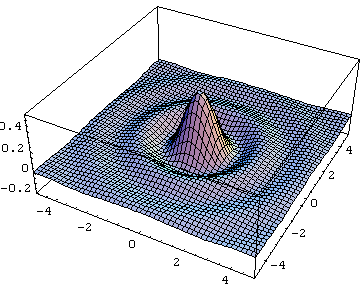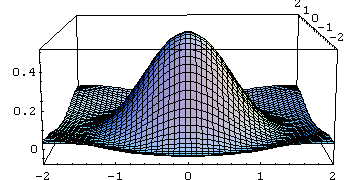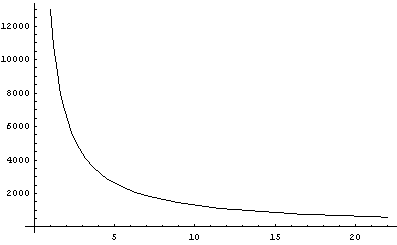
1. Wavelength etc.
2. Resolution and f number
- new section
* 1. Points
to note
* 2. Article
proper
The wavelength of red light is approximately  . Now that's pretty small.
. Now that's pretty small.
This means that an inch contains 31750 wavelengths of red light, or that a wavelength is 1/31750 of an inch. It's only 30 thousand wavelengths to an inch. I thought it was more.
2. Resolution and f number - new section
2.1. Points to note
There are some issues in the analysis below which will be fixed in the sequel. They are: 1. The Rayleigh resolution as mentioned applies to rectangular coordinates. A slightly different result holds for the circular system used. 2. This analysis is done for a single wavelength of light (red). Results for a full spectrum are different. It is possible that this fuller analysis might be added in the future. 3. A technique called super resolution can perform a deconvolution and the net result can be resolutions better than the theoretical limit. Much more can be said here, but there is no free lunch. 4. Generally amplitude distributions are shown, whereas the Airy disk concept refers to the intensity of light, which is the amplitude squared. This inaccuracy does not change the zero crossing, on which the main conclusion of this article is based. 5. Resolution analysis is more accurately replaced by so-called MTF analysis. Actually resolution is not a black and white concept, and an analysis based on MTF is more accurate, but not binary. These more advanced concepts are out of the scope of this pop article.
2.2. Article proper
I have been taking pictures for years and I suppose that I still don't know what I am doing. I am used to mounting a camera on a tripod and then stopping down to f22, f32, and sometimes even down to f64, to "get more resolution". Well it turns out that you get better depth of field when you stop down, but the resolution, as I discuss here, decreases. It decreases more than I had expected. I do some technical calculations to support this point.
Assuming that a lens is perfect and has no aberrations of any kind, an imaging system is still limited by the physical wave nature of light. This diffraction effect limits the resolution of an optical system. It determines the very best case in which you have an infinitely expensive and perfect lens. It's the best you can do.
A point of light passing through an ideal lens that is focused onto a film plane becomes less than an ideal point due to the effects of diffraction. Doing some analysis (and leaving out much technical stuff for this pop article), a point is imaged onto a light distribution called the Airy disk shown below.

Now I try to get a "fatness" concept from this distribution. Obviously we need to make some assumptions. I will assume that the width of the point is the fatness of the airy disk shown on its side view below.

Here I assume that "fatness" of the smeared out point of light is the width of the Airy disk shown above. Specifically (and for technical reasons involving Bessel functions) I assume that the "size" of the imaged point extends from -1.22 to 1.22 in the picture.
Technically therefore I am using a diffraction limited point size which is determined by the first zero of the Airy disk shown above. By comparison, the so called Rayleigh resolution limit is half this number or from 0 to 1.22. (So if you wish to add a factor of two in the analysis below, go right ahead.)
Scaling relationships show that the width of the curve above is
directly proportional to the  (f number) of your optical system. Thus if you double the
(f number) of your optical system. Thus if you double the  number, the width of the imaged point
gets twice as wide. Thus high
number, the width of the imaged point
gets twice as wide. Thus high  numbers degrade the resolution of a system. But by how
much.
numbers degrade the resolution of a system. But by how
much.
Using the width of a pixel as extending from -1.22 to 1.22 in the above Airy disk distribution of light, one can calculate how many of such disks will fit into a one inch size detector (or film). This calculation is for red light whose wavelength is 800 nm, which gives the fattest curve. This relationship is shown in the picture below.

Now we realize that the number of Airy disks (from -1.22 to
1.22) that will fit is the same thing as a resolution of a digital
camera. So the above graph gives the theoretically best resolution
on a one inch detector (or film) for a given  . (If you use the Rayleigh criterion,
double the above numbers.)
. (If you use the Rayleigh criterion,
double the above numbers.)
So I am shooting at f22 to get great depth of field. But, low and behold, the resolution is about 600. (The "best case" Rayleigh resolution calculation gives double this number or 1200 pixels.) The degradation due to high f number is worse than I thought.
This shows that there is basically no free lunch. Those monster (and monster expensive) f2.8 lenses give a resolution of 4647, just a touch better than the best digital camera resolutions obtainable at any price. So you want a 4K resolution picture. Huh, not only do you need to spend a gillion dollars on the camera, but you have to fork over another gillion on a f2.8 lens.
Most of my shots are taken at f8, which gives a best case resolution (regardless of camera or lens) of 1627.
Digital camera versus film? In many cases the answer is determined by the f number. There are many cases where reasonably priced digital cameras will compete on a resolution basis with film. This is because a point of light can only get so narrow, and if your detector is small enough, you can actually capture it digitally! Previous to doing this analysis, I had thought that film was a factor of 10 or 100 better in each dimension, and maybe it is, but the diffraction limitations of the optics itself put a limit on how much detector resolution is enough. Digital cameras are rapidly approaching this point of physical limitation. Not that that will stop the marketers.
Lastly I give the formula I used to obtain the above curve. The width of the Airy disk (from -1.22 to 1.22), properly scaled to the physical units of the problem, gives the width Q of the spread out point of light as

The width Q is proportional to the f number, and is also
proportional to the wavelength. Using the wavelength of red light
as lambda we obtain the formula for the resolution versus f number:
 This formula was used to
obtain the above curve.
This formula was used to
obtain the above curve.